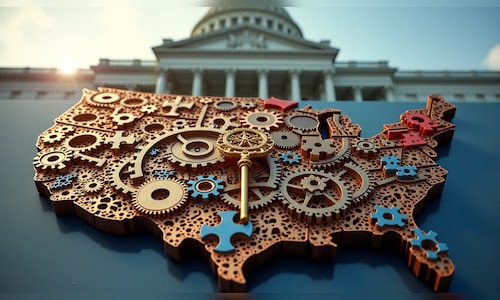[ad_1]
It’s not so much how you win as where you win that’s important.
This about sums up how the United States elects its president — a few states hold the key and the attention of every candidate running for the Oval Office. In other words, this is how the US Electoral College works.
The Electoral College system plays a pivotal role in determining the outcome of US presidential elections. This unique method of selecting the nation’s leader has been a cornerstone of American democracy since the country’s founding. Despite its long-standing nature, many still ask, “What is the Electoral College?” and “How does the Electoral College work?”
Let’s try and understand.
Historical development of the electoral college
The Electoral College was established during the Constitutional Convention of 1787 as a compromise between those who favoured direct popular election of the president and those who preferred selection by Congress. The founding fathers of the United States debated extensively, with some arguing for congressional selection and others insisting on a democratic popular vote. Their compromise resulted in the Electoral College system.
Initially, each elector cast two votes for president, with no distinction between presidential and vice-presidential votes. The candidate receiving the most votes became president, while the runner-up became vice president. This system led to complications, as seen in the 1800 election when Thomas Jefferson and Aaron Burr tied for first place.
The Twelfth Amendment, ratified in 1804, addressed these issues by requiring separate ballots for president and vice president. It also reduced the number of candidates from which the House could choose, from five to three, in case no candidate received a majority of electoral votes.
Also read: US Presidential Election 2024 | Challenges for India-US ties
The mathematics of winning
The US Electoral College system requires a candidate to secure 270 electoral votes out of 538 to win the presidency. The number of Electoral College votes in each state equals its total congressional representation. California, for instance, has the most, with 54, while several states have a minimum of three.
In most states, the candidate who wins the popular vote receives all that state’s electoral votes.
However, Maine and Nebraska use a different system, allocating two votes based on the statewide result and the rest according to congressional district outcomes.
This winner-take-all approach in most states means that candidates focus their campaigns on ‘swing states,’ where the outcome is uncertain, as winning these can significantly impact the Electoral College tally.
Controversies in recent elections
The US Electoral College system has faced significant scrutiny in recent years, mainly due to outcomes where the popular vote winner did not secure the presidency.
In the 2000 election, George W Bush won the Electoral College despite Al Gore receiving more popular votes. The election was marred by allegations of voter fraud and disenfranchisement, especially in Florida. The controversy culminated in a Supreme Court decision that ended recounts and gave Bush the victory.
Similarly, the 2016 election saw Donald Trump secure the presidency through the Electoral College despite Hillary Clinton winning the popular vote by nearly three million votes.
These instances have reignited debates about the fairness and effectiveness of the electoral college system in representing the will of the American people.
Also read: Bill Gates backs Kamala Harris with $50 million donation: Report
The future of presidential elections
The US Electoral College system faces ongoing scrutiny and potential reforms. Proposals to change the system include fusion voting, ranked-choice voting, and primary election reform.
Some states have joined the National Popular Vote Interstate Compact, agreeing to pledge their electors to the national popular vote winner. This compact would take effect once states with a majority of electoral votes join.
However, critics argue that such changes could face constitutional challenges. The debate continues as Americans grapple with the balance between preserving tradition and ensuring fair representation in presidential elections.
In conclusion
The complex mechanism of the Electoral College system, rooted in historical compromise, continues to shape the political landscape and influences campaign strategies.
The system’s ability to sometimes produce outcomes where the popular vote winner doesn’t secure the presidency has sparked ongoing debates about its fairness and effectiveness in representing the will of the American people.
Also read: Nearly 25 million votes already cast as Harris, Trump hit battleground states
[ad_2]
Source link










